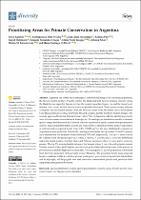Prioritizing areas for primate conservation in Argentina
Date
2022-11-15Author
Agostini, Ilaria
Velazco, Santiago José Elías
Insaurralde, Juan Ariel
Pavé, Romina
Holzmann, Ingrid
Fernández-Duque, Eduardo
Tujague, María Paula
Peker, Silvana
Kowalewski, Martín M.
Di Bitetti, Mario Santiago
Metadata
Show full item recordAbstract
Argentina lies within the southernmost distributional range of five neotropical primates, the brown howler monkey Alouatta guariba, the black-and-gold howler monkey Alouatta caraya, the black-horned capuchin Sapajus nigritus, the Azara’s capuchin Sapajus cay, and the Azara’s owl monkey Aotus azarae; the first three of which are globally threatened. These species occupy different ecoregions: the Alto Paraná Atlantic forest, the Araucaria moist forest, the humid Chaco, the Southern Cone Mesopotamian savanna, the Paraná Ffooded savanna, and the Southern Andean Yungas. The recently approved National Primate Conservation Plan of Argentina calls for identifying priority areas to focus conservation actions for these species. We used species distribution models to estimate species ranges and then used the Zonation software to perform a spatial conservation prioritization analysis based on primate habitat quality and connectivity to identify potential areas of importance at national and ecoregional levels. Only 7.2% (19,500 km2) of the area inhabited by primates in Argentina is under protection. Outside the current protected areas, the top-ranked 1% and 5% priority areas identified in our analysis covered 1894 and 7574 km2, respectively. The top 1% areas were in the Atlantic forest of Misiones province, where S. nigritus, A. guariba, and A. caraya are distributed, and in the humid portion of eastern Chaco and Formosa provinces, where A. azarae and A. caraya are present. The top 5% areas included portions of the Yungas, where S. cay is the only primate present. Priority areas in Chaco and Formosa provinces are particularly relevant because of the paucity of protected areas and the high deforestation rate. The endangered A. guariba population will benefit from the better protection of the priority areas of Misiones. The potential priority areas proposed herein, considered within a context of a broad participatory process involving relevant stakeholders and local people, will help guide new and innovative conservation policies and practices while supporting management objectives.
Collections
The following license files are associated with this item:



